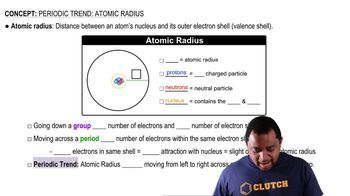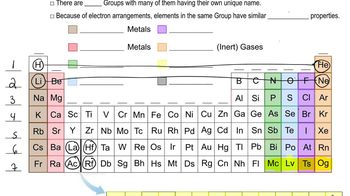Here are the essential concepts you must grasp in order to answer the question correctly.
Atomic Radius
Atomic radius is a measure of the size of an atom, typically defined as the distance from the nucleus to the outermost electron shell. It varies across the periodic table, generally increasing down a group due to the addition of electron shells and decreasing across a period due to increased nuclear charge, which pulls electrons closer to the nucleus.
Recommended video:
Periodic Trends
Periodic trends refer to the predictable patterns observed in the properties of elements as you move across or down the periodic table. Key trends include atomic radius, ionization energy, and electronegativity, which help in understanding how elements behave and interact with one another based on their position in the table.
Recommended video:
Group and Period Relationships
Elements are organized into groups (columns) and periods (rows) in the periodic table. Elements in the same group share similar properties and have the same number of valence electrons, while elements in the same period have the same number of electron shells. Understanding these relationships is crucial for predicting atomic size and other chemical properties.
Recommended video:
Periodic Table: Group Names
 Verified step by step guidance
Verified step by step guidance

